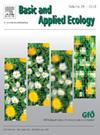Strategic selection of polliniser trees can improve fruit quality of lychee, a crop that exhibits mixed-mating
IF 3.5
2区 环境科学与生态学
Q2 ECOLOGY
引用次数: 0
Abstract
Fruit trees are often planted in single-cultivar blocks that allow convenient orchard management. This planting design can reduce the opportunities for cross-pollination, decreasing fruit quality if many harvested fruit result from selfing rather than outcrossing. We aimed to: (1) identify flower visitors in a lychee orchard; (2) determine levels of selfing and outcrossing among two lychee cultivars (Kaimana and Kwai Mai Pink) at increasing distances from another cultivar in single-cultivar blocks; and (3) assess effects of pollen parentage on fruit size, skin colour, Brix, acidity, and mineral nutrient concentrations. The European honeybee and a rhiniid fly, Stomorhina discolor, were the most abundant flower visitors. Pollinators appeared to transport cross-pollen at similar levels among the different rows within the single-cultivar blocks. Kaimana trees produced a mixture of selfed and outcrossed fruit. Kwai Mai Pink trees produced more selfed fruit, with at least 75 % being self-fertilised and 19 % being cross-fertilised. Cross-pollination of Kaimana by Souey Tung or Fay Zee Siu increased fruit flesh mass by 27 % and 26 % compared with self-pollinated fruit, respectively, and whole-fruit mass by 20 % and 21 %, respectively. Cross-pollination of Kaimana by Souey Tung also provided the fruit with a small seed and a redder skin. Cross-pollination of Kwai Mai Pink by Wai Chee did not affect the fruit mass or colour compared with self-pollinated fruit. Cross-pollination did not significantly affect Brix, acidity, or mineral nutrient concentrations of Kaimana or Kwai Mai Pink fruit. The results demonstrate that these cultivars have a mixed mating system and that flower visitors transport cross-pollen across many orchard rows. The results also indicate that strategic selection and planting of polliniser cultivars, that provide an optimal pollen genotype, could lead to the production of heavier lychee fruit with improved skin colour and seed size.
通过对传粉树种的战略性选择,可以提高荔枝的果实质量
果树通常种植在单一品种块,方便果园管理。这种种植设计可以减少异花授粉的机会,如果许多收获的果实是自交而不是异交,则会降低果实质量。我们的目标是:(1)识别荔枝果园里的赏花游客;(2)测定两个荔枝品种(Kaimana和Kwai Mai Pink)在与另一个品种的距离增加时的自交和异交水平;(3)评价花粉亲本对果实大小、果皮颜色、糖度、酸度和矿质养分浓度的影响。欧洲蜜蜂和鼻蝇(Stomorhina discolor)是数量最多的访花昆虫。传粉者在单品种块内不同行间传粉的水平相似。凯马纳树产生了自交和异交的混合果实。葵麦粉树产生更多的自交果实,至少75%是自交受精,19%是异交受精。经Souey Tung和Fay Zee Siu异花授粉的Kaimana果实果肉质量分别比自花授粉的果实增加27%和26%,全果质量分别增加20%和21%。Souey Tung对Kaimana的异花授粉也使其种子小,表皮更红。与自花授粉相比,惠芝异花授粉对葵麦粉的果实质量和颜色没有影响。异花授粉对凯麦粉和桂麦粉果实的糖度、酸度和矿质养分浓度影响不显著。结果表明,这些品种具有混合交配系统,并且访花者在许多果园行之间传递交叉花粉。结果还表明,提供最佳花粉基因型的授粉品种的战略性选择和种植可能导致生产更重的荔枝果实,改善果皮颜色和种子大小。
本文章由计算机程序翻译,如有差异,请以英文原文为准。
求助全文
约1分钟内获得全文
求助全文
来源期刊

Basic and Applied Ecology
环境科学-生态学
CiteScore
6.90
自引率
5.30%
发文量
103
审稿时长
10.6 weeks
期刊介绍:
Basic and Applied Ecology provides a forum in which significant advances and ideas can be rapidly communicated to a wide audience. Basic and Applied Ecology publishes original contributions, perspectives and reviews from all areas of basic and applied ecology. Ecologists from all countries are invited to publish ecological research of international interest in its pages. There is no bias with regard to taxon or geographical area.
 求助内容:
求助内容: 应助结果提醒方式:
应助结果提醒方式:


